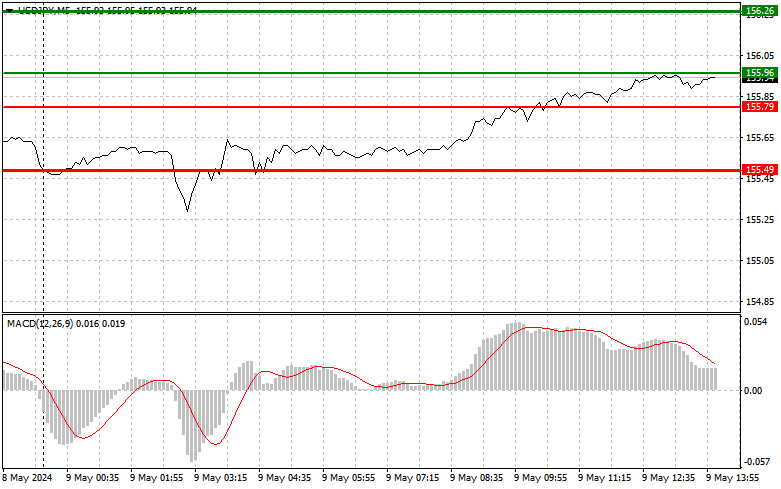Trade analysis and tips for trading the Japanese yen
The tests of the levels I indicated did not occur in the first half of the day, although the pair traded fairly close to the price of 155.96. Against this background, I was forced to review the technical picture and narrow down the nearest levels from which I plan to make decisions. I would like to see some movement in the second half of the day, which the US labor market reports may trigger, although this is unlikely. Data on initial jobless claims and weekly numbers of repeat claims for unemployment benefits in the US are expected, where fairly good figures will only strengthen the dollar buyers' positions in the market. As for the intraday strategy, I plan to act based on the implementation of scenarios #1 and #2.
Buy Signal
Scenario #1: Today, I plan to buy USD/JPY when the entry point reaches around 155.96 (green line on the chart), with a target of rising to the level of 156.26 (thicker green line on the chart). At 156.26, I will exit the purchases and open sales in the opposite direction (aiming for a movement of 30-35 points in the opposite direction from the level). Today, you can expect the pair to rise in continuation of the bull market. Important! Before buying, make sure that the MACD indicator is above the zero mark and is just starting to rise from it.
Scenario #2: I also plan to buy USD/JPY today in case of two consecutive tests of the price at 155.79 when the MACD indicator is in oversold territory. This will limit the pair's downward potential and lead to a reversal of the market upward. Expect a rise to the opposite levels of 155.96 and 156.26.
Sell Signal
Scenario #1: Today, I plan to sell USD/JPY after the level of 155.79 is updated (red line on the chart), which will lead to a rapid decline in the pair. The key target for sellers will be the level of 155.49, where I will exit the sales and also immediately open purchases in the opposite direction (aiming for a movement of 20-25 points in the opposite direction from the level). Pressure on the pair will return in case of very poor data on the US labor market and problems overcoming the daily high. Important! Before selling, make sure that the MACD indicator is below the zero mark and is just starting to decline from it.
Scenario #2: Today, I also plan to sell USD/JPY in case of two consecutive tests of the price at 155.96 when the MACD indicator is in overbought territory. This will limit the pair's upward potential and lead to a reversal of the market downward. Expect a decline to the opposite levels of 155.79 and 155.49.
What's on the chart:
Thin green line – entry price, at which you can buy the trading instrument.
Thick green line – the expected price where you can set Take Profit or manually take profits, as further growth beyond this level is unlikely.
Thin red line – entry price, at which you can sell the trading instrument.
Thick red line – the expected price where you can set Take Profit or manually take profits, as further decline below this level is unlikely.
MACD indicator. When entering the market, it is important to follow overbought and oversold zones.
Important. Beginner traders in the forex market need to be very cautious when making decisions to enter the market. Before important fundamental reports are released, it is best to stay out of the market to avoid being caught in sharp exchange rate fluctuations. If you decide to trade during news releases, always place stop orders to minimize losses. You need to set stop orders to avoid losing your entire deposit, especially if you don't use money management and trade with large volumes.
And remember, successful trading requires a clear trading plan similar to the one I presented above. Spontaneous trading decisions based on the current market situation are initially a losing strategy for an intraday trader.